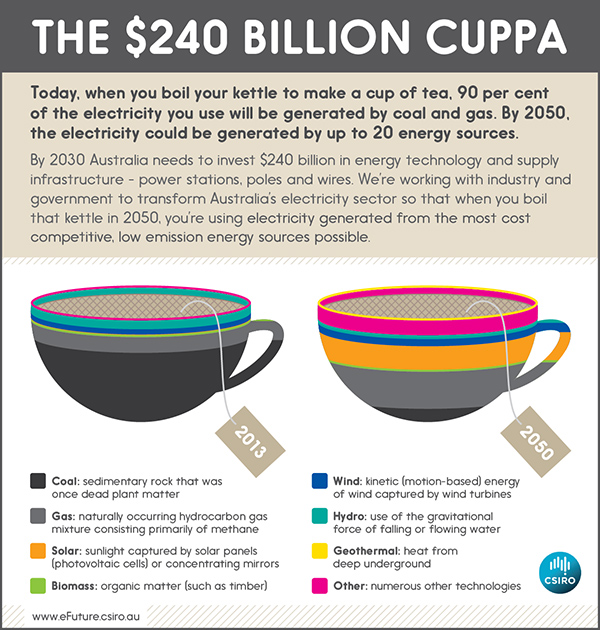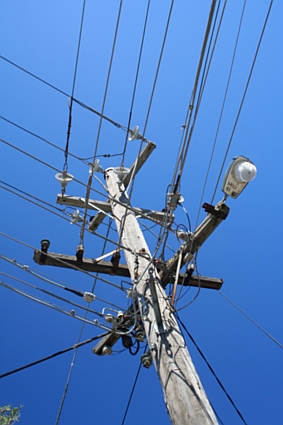
By Dr Luke Reedman
Next time you boil the kettle in your kitchen or office, have a think about this: over 90 per cent of the electricity used today is being generated by coal and gas. By 2050, when you do the same thing – make a cuppa – the electricity you use could be generated by over 20 energy sources and technologies. That’s a big change.
In some future scenarios we could be looking at an even split between renewable and conventional coal and gas power stations – with some potentially using carbon capture and storage technologies, significantly decreasing our carbon emissions.
“So what,” I hear you say? “As long as I can make that cuppa, right?”
Wrong. What if you had $240 billion dollars to spend to give the electricity sector the makeover it needs to help with the transition to a much more diverse mix of 20 plus energy technologies? This is the challenge facing Australia’s electricity sector today and it has been coined the ‘energy transformation’, a transformation not seen since the industrial revolution.
There are many factors fuelling this transformation; including the take up of photovoltaic (PV) solar panels and the steadily decreasing prices of new low emission technologies, including PV.
Households are becoming energy generators. One in ten Australian homes now has solar panels installed; totalling 17,354,018 metres squared of PV power generation- that’s the equivalent of 860 MCGs. This is called distributed generation and poses challenges to the electricity grid because predictable energy demanders (consumers) are suddenly changing their energy consumption behaviour. The electricity grid must learn to operate as a ‘transaction enabler’ for these new generators rather than simply a one way delivery system.
The increasing take-up of PV and other new technologies is driven by dramatic price reductions. PV has halved in price since 2008 and wind farms have increased tenfold in just a decade. The main implication is that renewables are much more commercially viable. The key question now is not whether renewable will ever make up a significant part of our electricity supply, but how will we best manage that transition given they are so different to the existing supply from conventional gas and coal fired power.
Decisions around investment and policy need to be made soon so that by 2050 when we are making that refreshing cup of Earl Grey, we are boiling the kettle using electricity generated from the most cost competitive, low emission energy sources possible.
The future of Australia’s electricity supply and the electricity grid is something CSIRO is exploring through the Future Grid Forum and the Future Grid Research Cluster.
The Future Grid Forum is an Australian first collaboration that brings together the entire electricity sector – over 40 electricity generators, distributors, transmission service providers, retailers, regulators, government, consumer and environment groups – to create a road map for the future of the electricity sector. The Road Map will be released at the end of 2013.
Building on the Forum, in May 2013 CSIRO launched a new $13 million research collaboration, the Future Grid Cluster. Four universities – University of Sydney, University of Newcastle, University of Queensland and University of NSW – will work with CSIRO to develop a suite of tools to understand, develop and optimise energy grids of the future.
So, we have it all in hand I guess. Now, time to make that cuppa.
Read the full news release here.
Media: Linley Davis. Phone: +61 2 4960 6116. Mobile: +61 417 772 480. Email: Linley.Davis@csiro.au


5th January 2014 at 12:51 pm
The dream costs a mere $240 billion by 2030. Paying the politicised CSIRO to come up with this computer modelling garbage should cease immediately and the money saved put into companies who may actually develop some form of useful renewable energy in the future that doesn’t involve another dream of ‘smart grids’ that no one will ever put together without bankrupting the country first. Like most salaried public servants the CSIRO hasn’t a clue about what happens to people who have to live with the result of paying for fantasies gone mad.
1st July 2013 at 8:57 pm
Dear Dr Luke,
thanks for the appreciation of the complexity of our new grid. Just as well the poles and wires and gen folks are smart, love a challenge to solve a decent problem they can sink their teeth into and not a bunch of gold plating rent seekers.
I would like to note my curiosity that there was a suggestion of a viable scenario that would be ‘significantly decreasing our carbon emissions’. To my mind the ‘viable scenario’ is one that would get us to 100% renewable. A feasible means of doing this has been worked through by Beyond Zero Emissions. And there is another curiosity; a fully fledged response to global warming has had to be developed by a civil society group. Where are government, business and science in proposing leadership solutions to being at 400ppm?
thanks, once again for summarising some of the concepts we need to come to grips with in a renewable energy supply world.
5th June 2013 at 11:18 am
I would hope that by 2050 we are not “boiling a kettle” for one or two cups of tea! There is far too much wasted heat energy unless the kettle is filled to exactly the right volume to suit the number of cups required. Many people boil at least a half-full kettle to make a single cup leaving much of the heating energy to be wasted in subsequent cooling to atmosphere. It would be far more efficient to have a simple means of boiling the water in the cup (microwave or immersion heater – technologies and tools that we already have) and use better education to direct and encourage energy saving behaviours. Yes let’s have the research and development of new sustainable technologies – but not without cutting the substantial amounts of waste inherent in our current systems, practices and behaviours as an immediate priority.